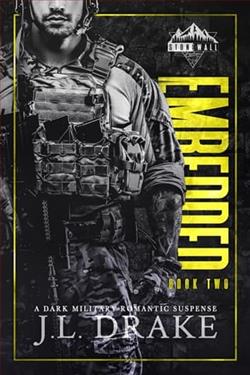Page 8 of Men In Blue (Badge of Honor 1)
The Police Administration Building on Vine Street in downtown Philadelphia is what in another city would be called “police headquarters.” In Philadelphia it is known to the police and public as “the Roundhouse.”
The architect who envisioned the building managed to pass on his enthusiasm for the curve to those city officials charged with approving its design. There are no straight corridors; the interior and exterior walls, even those of the elevators, are curved.
The Radio Room of the Philadelphia Police Department is on the second floor of the Roundhouse. Within the Radio Room are rows of civilian employees, leavened with a few sworn police officers, who sit at telephone and radio consoles receiving calls from the public, and from police vehicles “on the street” and relaying official orders to police vehicles.
There are twenty-two police districts in Philadelphia, each charged with maintaining the peace in its area. Each has its complement of radio-equipped police cars and vans. Additionally, there are seven divisions of detectives, occupying office space in district buildings, but answering to a detective hierarchy, rather than to the district commander. They have their own, radio-equipped, police cars.
Radio communication is also maintained with the vehicles of the Philadelphia Highway Patrol, which has its own headquarters; with the vehicles of the Traffic, Accident, and Juvenile divisions; with the fleet of police tow trucks; and with the vehicles of the various special-purpose units, such as the K-9 Unit, the Marine Unit, the Vice, Narcotics, Organized Crime units, and others.
And on top of this, of course, is the necessity to maintain communications with the vehicles of the senior command hierarchy of the police department, the commissioner, and his staff; the deputy commissioners and their staffs; the chief inspectors and their staffs; and a plethora of other senior police officers.
With more than a thousand police vehicles “on the street” at any one time, it was necessary to develop, both by careful planning and by trial and error, a system permitting instant contact with the right vehicle at the right time. The police commissioner is not really interested to learn instantly of every automobile accident in Philadelphia, nor is a request from the airport police for a paddy wagon to haul off three drunks from the airport of much interest to a detective looking for a murder suspect in an alley off North Broad Street.
So far as the police were concerned, Philadelphia was broken down into seven geographical divisions, each headed by an inspector. Each division contained from two to four districts, each headed by a captain. Each division was assigned its own radio frequency. Detectives’ cars and those assigned to other investigative units (Narcotics, Intelligence, Organized Crime, et cetera) had radios operating on the H-Band. All police car radios could be switched to an all-purpose emergency and utility frequency called the J-Band.
For example, a police car in the Sixteenth District would routinely have his switch set to F-l, which would permit him to communicate with his (the West) division. Switching to F-2 would put him on the universal J-Band. A car assigned to South Philadelphia with his switch set to F-l would be in contact with the South Division. A detective operating anywhere with his switch set to F-l would be on the (Detectives’) H-Band, but he too, by switching to F-2, would be on the J-Band.
Senior police brass are able to communicate with other senior police brass, and most often on the detective frequency or on the frequency of some other service in which he has a personal interest. Ordinary police cars are required to communicate through the dispatcher, and forbidden to talk car-to-car. Car-to-car communication is authorized on the J- and H-bands.
“Communications discipline” is strictly enforced. Otherwise, there would be communications chaos.
By throwing the appropriate switch, a Radio Room dispatcher may send a radio message to every radio-equipped vehicle, from a police boat making its. way against the current of the Delaware River, through the hundreds of police cars on patrol, to the commissioner’s car.
It happens when a light flashes on a console and an operator throws a switch and says, “Police Radio,” and the party calling says, “Officer needs assistance. Shots fired.”
Not every call making such an announcement is legitimate. The wise guys have watched cop movies on television, and know the cant; and ten or twelve times every day they decide that watching a flock of police cars, lights flashing and sirens screaming, descend on a particular street corner would be a good way to liven up an otherwise dull afternoon.
The people who answer the telephones didn’t come to work yesterday, however, and sometimes they know, by the timbre of the caller’s voice possibly, or the assurance with which the caller raises the alarm, that this call is legitimate.
The dispatcher who took Captain Richard C. “Dutch” Moffitt’s call from the Waikiki Diner was Mrs. Leander Polk, forty-eight, a more than pleasantly plump black lady who had been on the job for nineteen years.
“Lieutenant!” she called, raising her voice, just to get his attention, not to ask his permission.
Then she threw the appropriate switch.
Two beeps, signifying an emergency message, were broadcast to every police radio in Philadelphia.
“Roosevelt Boulevard and Harbison,” Mrs. Polk said clearly. “The Waikiki Diner. Assist officer. Police by phone.”
She repeated that message once again, and then went on: “Report of a robbery, shooting, and hospital case.” She repeated that, and then, quickly, to the lieutenant who had come to her station: “Captain Moffitt called it in.”
And then she broadcast: “All cars going in on the assist, Harbison and the Boulevard, flash information on a robbery at that location. Be on the lookout for white male, long blond hair, brown jacket, direction taken unknown’ armed with a gun.”
And then she repeated that.
TWO
Highway Two-B was a Philadelphia Highway Patrol vehicle moving southward on Roosevelt Boulevard, just entering Oxford Circle. It was occupied by Sergeant Alexander W. Dannelly, and driven by Police Officer David N. Waldron. Sergeant Dannelly and Officer Waldron had moments before seen Captain Dutch Moffitt going into the Waikiki Diner, dressed to kill in civvies.
It was four in the afternoon, and Captain Dutch Moffitt usually worked until half-past five, and often longer. And in uniform.
“The captain is obviously engaged in a very secret undercover investigation,” Sergeant Dannelly said.
“Under-the-covers, you said, Sergeant?” Officer Waldron asked, grinning.
“You have an evil mind, Officer Waldron,” Sergeant Dannelly said, grinning back. “Shame on you!”
“How about a cup of coffee, Sergeant?” Waldron asked. “The Waikiki serves a fine cup of coffee.”















